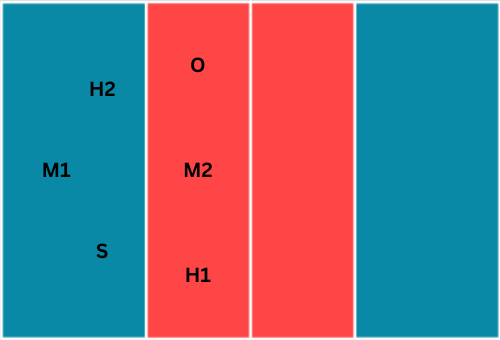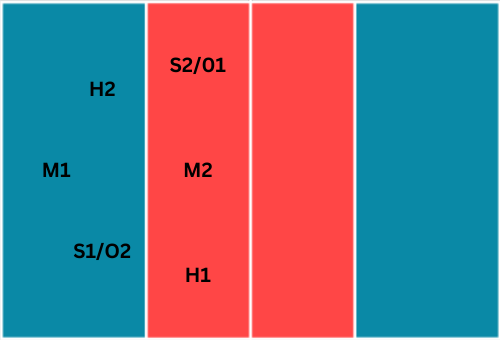Volleyball Court Positions: Understanding the Roles and Responsibilities

Volleyball is an exciting and dynamic sport that requires coordination, skill, and strategy. One key aspect of the game is understanding the different volleyball court positions and the responsibilities associated with each. In this article, we’ll dive deep into the world of volleyball court positions, exploring the roles, strategies, and importance of teamwork. Whether you’re a player, coach, or simply an enthusiast, this guide will provide you with valuable insights to enhance your understanding of the game.
The Basics of Volleyball Court Positions
Setter
The setter is often regarded as the quarterback of the team, responsible for orchestrating the offense. They are positioned in the middle-front area of the court, near the net. The primary role of the setter is to receive the first contact and set up the ball for an attacking player to spike.
Outside Hitter
The outside hitter, also known as the left-side hitter, is positioned on the left side of the front row. They are typically the primary attacking option and play a crucial role in scoring points for the team. Outside hitters receive sets from the setter and execute powerful spikes to overcome the opponent’s defense.
Opposite Hitter
The opposite hitter, also referred to as the right-side hitter, is positioned opposite the setter on the right side of the front row. They play a similar role to the outside hitter but on the opposite side of the court. Opposite hitters provide a different attacking angle and often contribute to blocking at the net.
Middle Blocker
The middle blocker, positioned in the middle of the front row, plays a vital role in both offense and defense. They are responsible for blocking the opponent’s attacks and executing quick attacks themselves. Middle blockers need to have excellent timing and agility to be effective.
Libero
The libero is a specialized defensive player who wears a different colored jersey. They play in the back row and have specific rules regarding rotation and substitution. The libero’s primary role is to receive serves and provide exceptional defensive skills, including digging and passing. They act as the team’s defensive anchor, ensuring stability and control in the backcourt.
Responsibilities of Each Position
Understanding the specific responsibilities of each volleyball court position is crucial for effective teamwork and optimal performance. Let’s delve into the responsibilities of each position in more detail.
Setter’s Responsibilities
The setter’s main responsibility is to create scoring opportunities for their teammates. They must accurately receive the first contact and set the ball in a way that allows the hitters to execute powerful attacks. Setters need exceptional hand-eye coordination, decision-making skills, and the ability to read the game.
Outside Hitter’s Responsibilities
Outside hitters play a vital role in the team’s offense. Their responsibilities include effectively receiving sets from the setter, executing powerful spikes, and finding ways to score points. Outside hitters need to possess strong attacking skills, agility, and the ability to adapt to different game situations.
Opposite Hitter’s Responsibilities
Similar to outside hitters, opposite hitters are responsible for scoring points through powerful attacks. They need to communicate effectively with the setter to establish a strong connection. Additionally, opposite hitters contribute to blocking at the net and play a crucial role in defending against the opponent’s attacks.
Middle Blocker’s Responsibilities
Middle blockers are responsible for both offensive and defensive tasks. They must effectively block the opponent’s attacks by jumping and timing their movements accurately. Offensively, middle blockers need to execute quick attacks, exploiting gaps in the opponent’s defense. They play a crucial role in controlling the net and disrupting the opponent’s offense.
Libero’s Responsibilities
The libero’s primary focus is on defense and passing. They must excel in receiving serves, digging the opponent’s attacks, and providing accurate passes to the setter. Liberos often specialize in reading the opponent’s offensive strategies, anticipating their moves, and making critical defensive plays.
Strategies and Tactics for Volleyball Court Positions
Each volleyball court position requires specific strategies and tactics to maximize performance and contribute to the team’s success. Let’s explore some strategies and tactics for each position.
Setter Strategies and Tactics
Setters need to establish effective communication with their teammates, understanding their preferences and strengths. They should analyze the opponent’s defense and make quick decisions on the type and location of sets. Setters should also vary the tempo and placement of their sets to keep the opponent’s blockers off balance.
Outside Hitter Strategies and Tactics
Outside hitters should focus on finding ways to score points by utilizing their attacking skills. They need to communicate with the setter to establish a strong connection and adjust their positioning based on the opponent’s blocking strategies. Outside hitters should also be adept at hitting with power and accuracy from various angles.
Opposite Hitter Strategies and Tactics
Opposite hitters should work closely with the setter to establish a strong offensive connection. They should be versatile in their attacking approach, capable of executing powerful spikes and finding gaps in the opponent’s defense. Opposite hitters should also contribute to the team’s blocking efforts, disrupting the opponent’s attacks.
Middle Blocker Strategies and Tactics
Middle blockers play a crucial role in both blocking and attacking. They should focus on quick footwork, precise timing, and effective reading of the opponent’s offense. Middle blockers should aim to close gaps in the block, frustrate the opponent’s hitters, and execute quick attacks to keep the opponent’s defense guessing.
Libero Strategies and Tactics
Liberos should excel in defensive skills, including digging and passing. They need to anticipate the opponent’s attacks, react quickly, and make accurate passes to the setter. Liberos should also communicate effectively with their teammates, providing instructions on defensive positioning and coordinating with the backcourt players. Their ability to read the game and make split-second decisions is crucial for successful defensive plays.
Importance of Communication and Teamwork
In volleyball, effective communication and teamwork are the foundations of a well-functioning team. Let’s explore how communication plays a vital role in each volleyball court position.
Setter’s Role in Communication
As the leader of the offense, the setter plays a crucial role in communication. They need to effectively communicate with all their teammates, providing instructions on the type and location of sets. Setters should also be vocal in directing the flow of the game, making quick decisions, and encouraging their teammates.
Communication between Hitters and Setter
Hitters and setters must establish a strong connection through constant communication. Hitters should effectively communicate their preferences, such as the type of set they prefer or the location they want to attack. This communication helps in maximizing scoring opportunities and adapting to the opponent’s defense.
Communication with the Libero
The libero acts as the defensive anchor of the team and plays a vital role in communication. They are responsible for organizing the backcourt defense and providing instructions to their teammates regarding defensive positioning. Liberos should effectively communicate with the hitters and setter, ensuring a cohesive defensive strategy.
Adapting to Different Systems and Formations
Volleyball teams employ various systems and formations based on their strengths, strategies, and opponent analysis. Let’s explore some commonly used systems.
5-1 System
In the 5-1 system, a single designated setter sets the ball in all rotations. This system allows for consistent setting and provides a stable offensive structure. The other players take on the roles of attackers and blockers, contributing to both offense and defense.

6-2 System
The 6-2 system involves two designated setters who switch positions between the front and back rows. This system provides flexibility in setting options and allows for additional attacking options. The two setters also contribute to blocking and defense when in the front row.

4-2 System
The 4-2 system features four hitters and two setters. The setters take on the setting responsibilities while in the front row, and one setter becomes a defensive specialist while in the back row. This system provides a balanced offense and ensures consistent setting options.

Training and Skills Development
To excel in their respective positions, volleyball players must undergo extensive training and develop specific skills. Let’s explore the training and skills required for each volleyball court position.
Setter’s Training and Skills
Setters should focus on developing their hand-eye coordination, agility, and decision-making abilities. They need to practice accurate setting from various positions and angles. Setters should also work on their communication skills and understanding the game’s dynamics to effectively orchestrate the offense.
Outside Hitter’s Training and Skills
Outside hitters should prioritize developing their attacking skills, including hitting power, accuracy, and versatility. They need to work on their footwork, jumping ability, and spatial awareness to find gaps in the opponent’s defense. Outside hitters should also focus on defensive skills, including digging and serving receive.
Opposite Hitter’s Training and Skills
Similar to outside hitters, opposite hitters should emphasize their attacking abilities. They need to practice hitting from different angles and distances, as well as working on their blocking skills. Opposite hitters should also develop their defensive skills, including digging and serving receive, to contribute to the team’s overall performance.
Middle Blocker’s Training and Skills
Middle blockers should prioritize developing their blocking skills, including footwork, timing, and reading the opponent’s attacks. They need to work on quick attacks and develop their hitting abilities. Middle blockers should also focus on defensive skills, including lateral movement and blocking coverage to effectively counter the opponent’s offensive strategies.
Libero’s Training and Skills
Liberos should focus on defensive skills, including digging, passing, and reading the opponent’s attacks. They need to work on their agility, quick reflexes, and court coverage. Liberos should also develop their communication skills and their ability to organize the backcourt defense effectively.
Conclusion
Understanding the roles and responsibilities of volleyball court positions is essential for successful gameplay. Each position brings unique skills and contributions to the team’s overall performance. Effective communication, teamwork, and adaptability to different systems and formations are crucial elements for success on the court. By investing in training and skill development specific to each position, players can enhance their abilities and contribute to their team’s victories.

FAQs
How can I improve my setting skills as a setter?
To improve your setting skills, practice consistent hand positioning, work on your footwork to quickly reach the ball, and develop your decision-making abilities. Focus on accuracy and varying the tempo and placement of your sets.
What are some essential skills for an outside hitter?
As an outside hitter, important skills include powerful and accurate spiking, agility, footwork, and the ability to adapt to different game situations. Work on your defensive skills such as digging and serving receive as well.
What is the role of a middle blocker in volleyball?
A middle blocker’s role is to effectively block the opponent’s attacks and execute quick attacks. They need to have precise timing, agility, and the ability to read the game to control the net and disrupt the opponent’s offense.
Can a libero attack or set the ball?
No, a libero cannot attack the ball from above the net or execute an overhead set. Their primary role is to excel in defensive skills such as digging and passing, providing stability and control in the backcourt.
How important is communication among teammates in volleyball?
Communication is vital in volleyball. It allows for effective coordination, understanding of each other’s preferences, and executing strategies. Clear and concise communication helps maximize scoring opportunities, defensive positioning, and overall team performance.


